University Students' Eating Habits: A Structured Literature Review
VerifiedAdded on 2023/04/21
|6
|1555
|188
Literature Review
AI Summary
This literature review examines the eating habits and dietary behaviors of university students, drawing upon multiple research articles. It covers various factors influencing these habits, including individual, societal, university-related, and environmental aspects. The review identifies common themes such as the prevalence of fast food consumption and differences in eating patterns between residential and non-residential students. It also highlights study limitations related to sample size, geographical focus, and research design, and discusses future research directions, including promoting healthy eating behaviors and developing effective interventions. The included studies employ both qualitative and quantitative methods, providing a comprehensive overview of the topic. Desklib provides solved assignments and past papers for students.
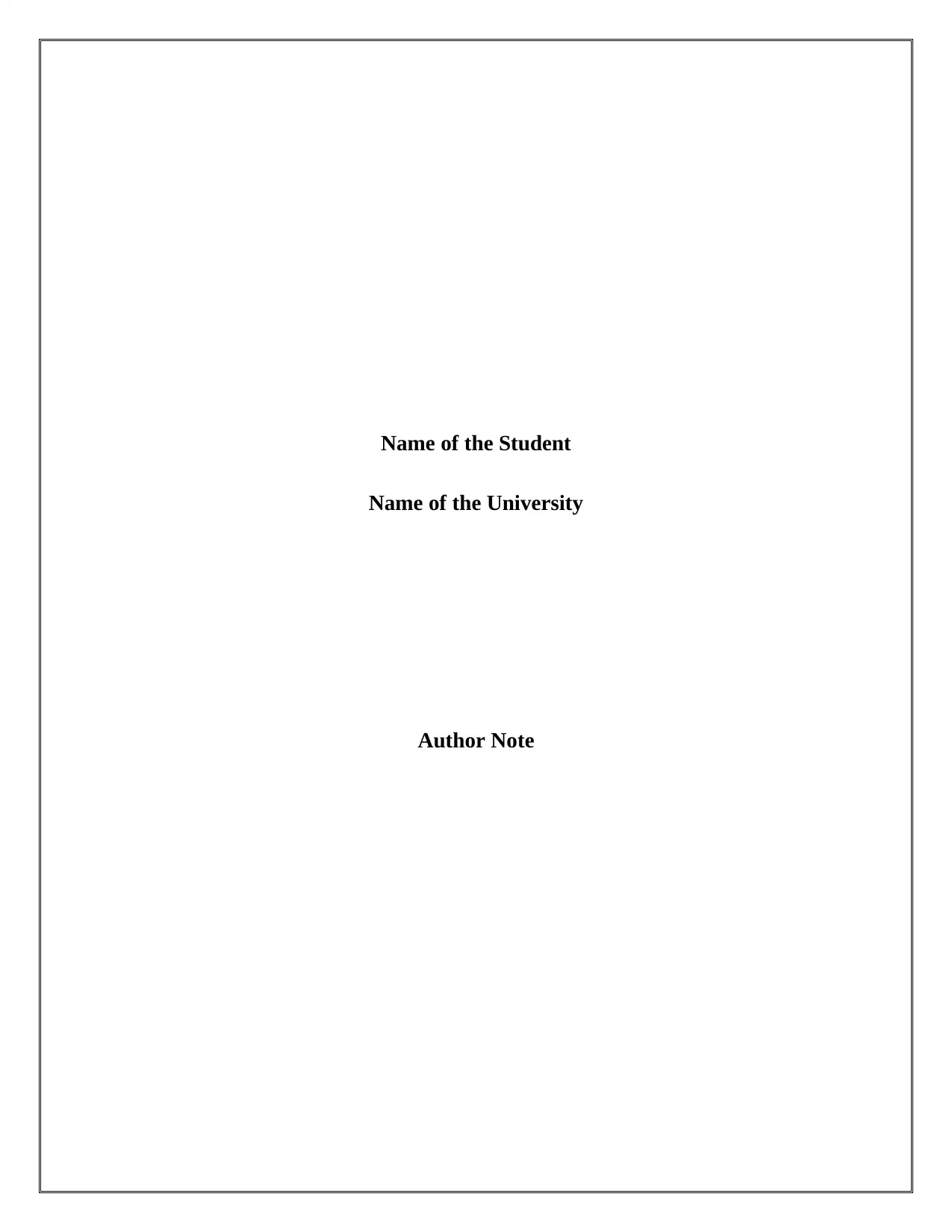
Name of the Student
Name of the University
Author Note
Name of the University
Author Note
Paraphrase This Document
Need a fresh take? Get an instant paraphrase of this document with our AI Paraphraser
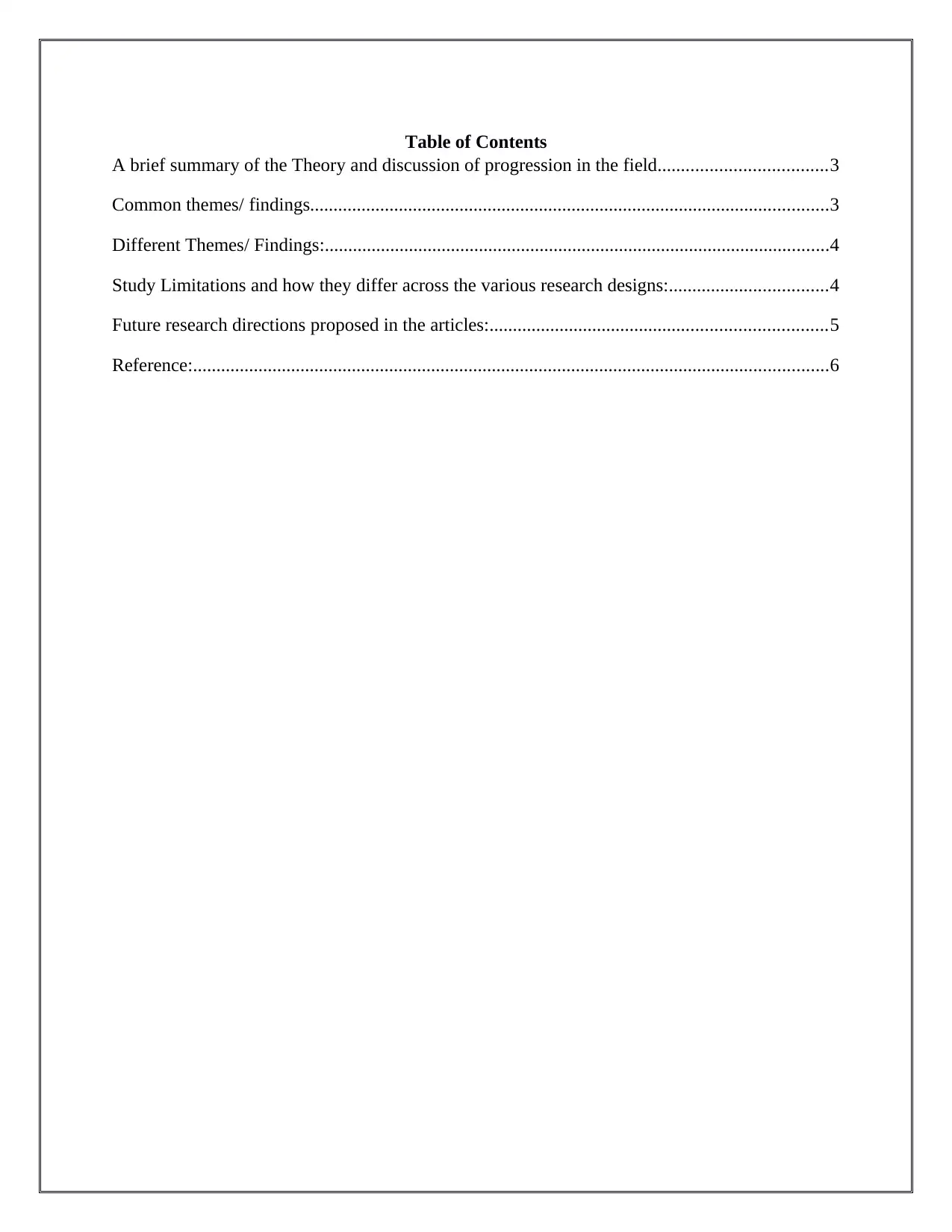
Table of Contents
A brief summary of the Theory and discussion of progression in the field....................................3
Common themes/ findings...............................................................................................................3
Different Themes/ Findings:............................................................................................................4
Study Limitations and how they differ across the various research designs:..................................4
Future research directions proposed in the articles:........................................................................5
Reference:........................................................................................................................................6
A brief summary of the Theory and discussion of progression in the field....................................3
Common themes/ findings...............................................................................................................3
Different Themes/ Findings:............................................................................................................4
Study Limitations and how they differ across the various research designs:..................................4
Future research directions proposed in the articles:........................................................................5
Reference:........................................................................................................................................6
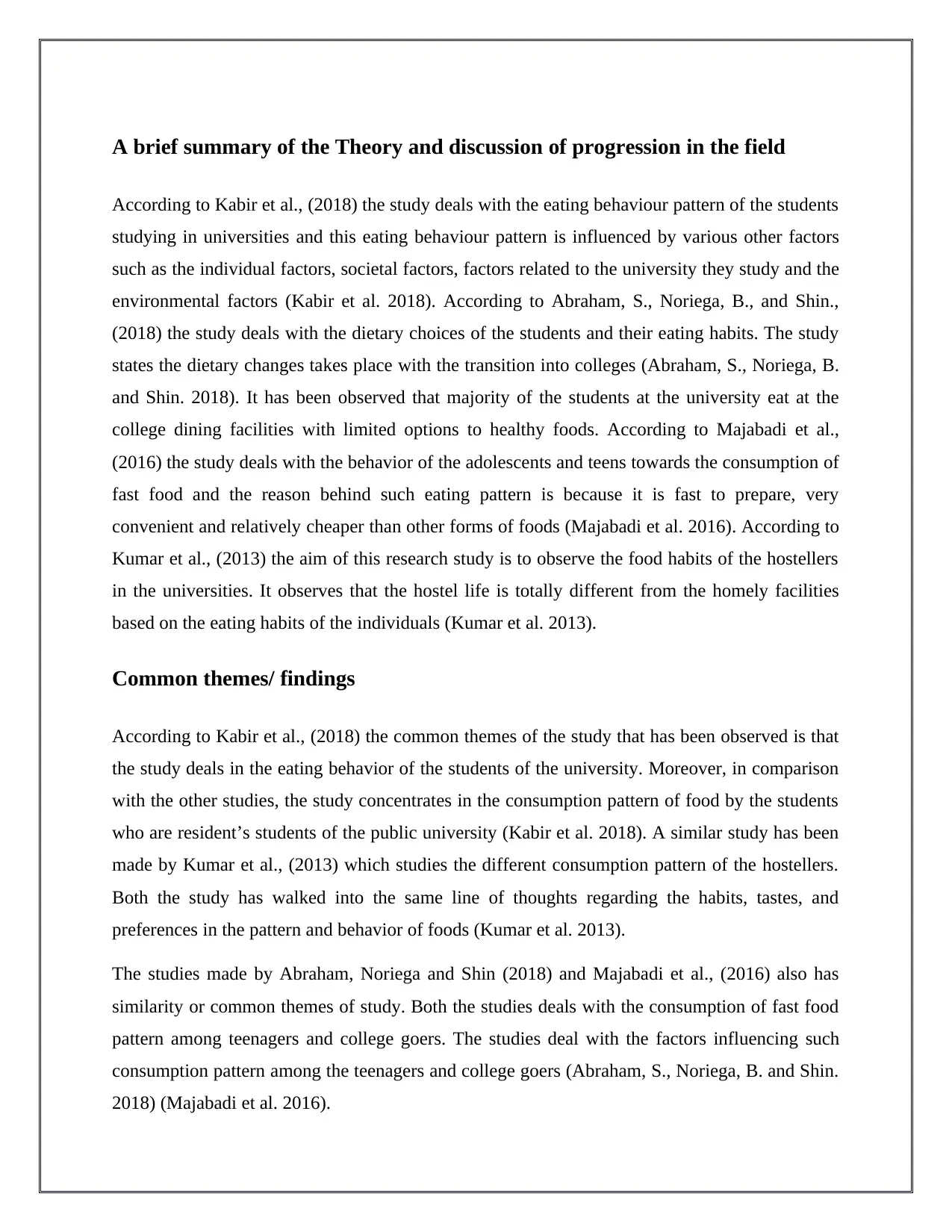
A brief summary of the Theory and discussion of progression in the field
According to Kabir et al., (2018) the study deals with the eating behaviour pattern of the students
studying in universities and this eating behaviour pattern is influenced by various other factors
such as the individual factors, societal factors, factors related to the university they study and the
environmental factors (Kabir et al. 2018). According to Abraham, S., Noriega, B., and Shin.,
(2018) the study deals with the dietary choices of the students and their eating habits. The study
states the dietary changes takes place with the transition into colleges (Abraham, S., Noriega, B.
and Shin. 2018). It has been observed that majority of the students at the university eat at the
college dining facilities with limited options to healthy foods. According to Majabadi et al.,
(2016) the study deals with the behavior of the adolescents and teens towards the consumption of
fast food and the reason behind such eating pattern is because it is fast to prepare, very
convenient and relatively cheaper than other forms of foods (Majabadi et al. 2016). According to
Kumar et al., (2013) the aim of this research study is to observe the food habits of the hostellers
in the universities. It observes that the hostel life is totally different from the homely facilities
based on the eating habits of the individuals (Kumar et al. 2013).
Common themes/ findings
According to Kabir et al., (2018) the common themes of the study that has been observed is that
the study deals in the eating behavior of the students of the university. Moreover, in comparison
with the other studies, the study concentrates in the consumption pattern of food by the students
who are resident’s students of the public university (Kabir et al. 2018). A similar study has been
made by Kumar et al., (2013) which studies the different consumption pattern of the hostellers.
Both the study has walked into the same line of thoughts regarding the habits, tastes, and
preferences in the pattern and behavior of foods (Kumar et al. 2013).
The studies made by Abraham, Noriega and Shin (2018) and Majabadi et al., (2016) also has
similarity or common themes of study. Both the studies deals with the consumption of fast food
pattern among teenagers and college goers. The studies deal with the factors influencing such
consumption pattern among the teenagers and college goers (Abraham, S., Noriega, B. and Shin.
2018) (Majabadi et al. 2016).
According to Kabir et al., (2018) the study deals with the eating behaviour pattern of the students
studying in universities and this eating behaviour pattern is influenced by various other factors
such as the individual factors, societal factors, factors related to the university they study and the
environmental factors (Kabir et al. 2018). According to Abraham, S., Noriega, B., and Shin.,
(2018) the study deals with the dietary choices of the students and their eating habits. The study
states the dietary changes takes place with the transition into colleges (Abraham, S., Noriega, B.
and Shin. 2018). It has been observed that majority of the students at the university eat at the
college dining facilities with limited options to healthy foods. According to Majabadi et al.,
(2016) the study deals with the behavior of the adolescents and teens towards the consumption of
fast food and the reason behind such eating pattern is because it is fast to prepare, very
convenient and relatively cheaper than other forms of foods (Majabadi et al. 2016). According to
Kumar et al., (2013) the aim of this research study is to observe the food habits of the hostellers
in the universities. It observes that the hostel life is totally different from the homely facilities
based on the eating habits of the individuals (Kumar et al. 2013).
Common themes/ findings
According to Kabir et al., (2018) the common themes of the study that has been observed is that
the study deals in the eating behavior of the students of the university. Moreover, in comparison
with the other studies, the study concentrates in the consumption pattern of food by the students
who are resident’s students of the public university (Kabir et al. 2018). A similar study has been
made by Kumar et al., (2013) which studies the different consumption pattern of the hostellers.
Both the study has walked into the same line of thoughts regarding the habits, tastes, and
preferences in the pattern and behavior of foods (Kumar et al. 2013).
The studies made by Abraham, Noriega and Shin (2018) and Majabadi et al., (2016) also has
similarity or common themes of study. Both the studies deals with the consumption of fast food
pattern among teenagers and college goers. The studies deal with the factors influencing such
consumption pattern among the teenagers and college goers (Abraham, S., Noriega, B. and Shin.
2018) (Majabadi et al. 2016).
⊘ This is a preview!⊘
Do you want full access?
Subscribe today to unlock all pages.

Trusted by 1+ million students worldwide
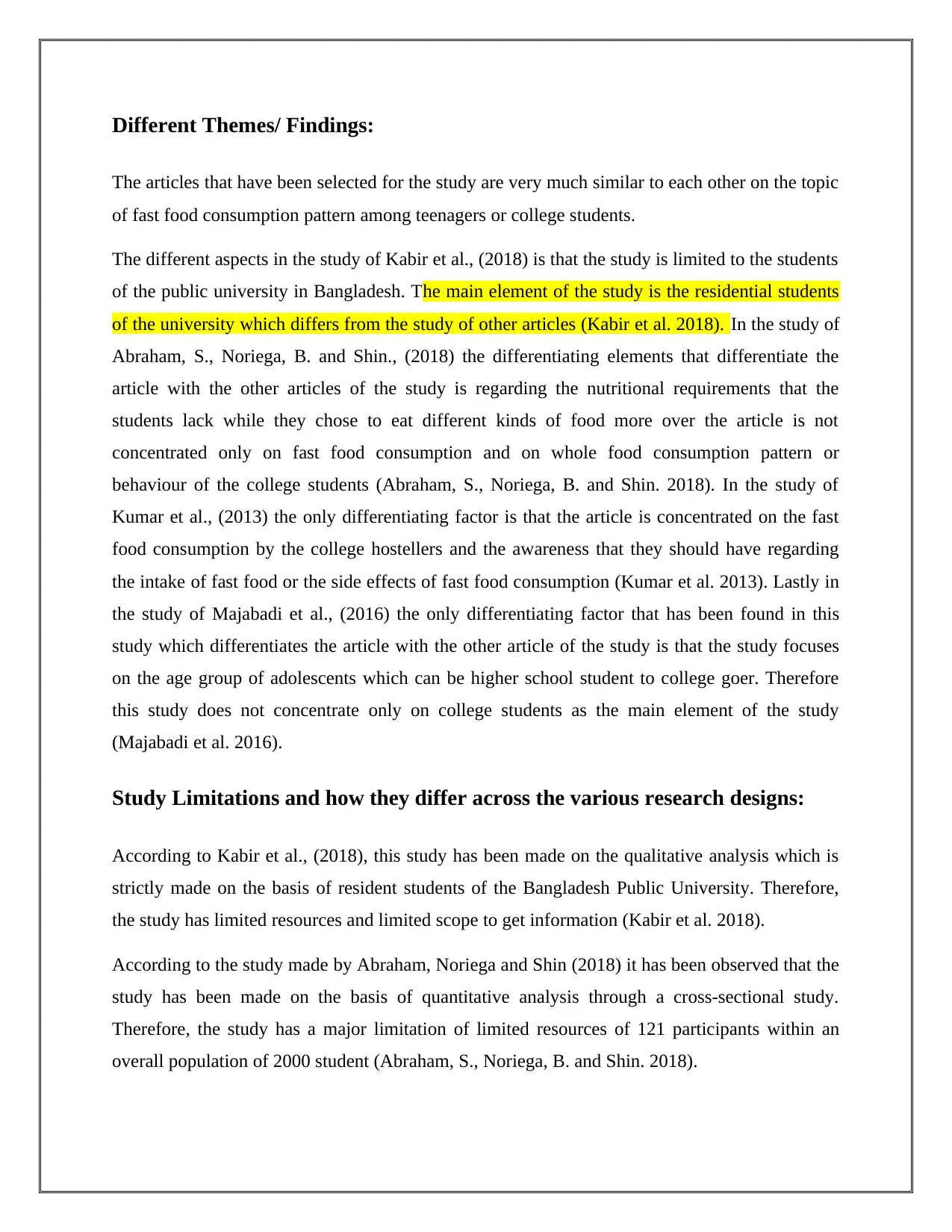
Different Themes/ Findings:
The articles that have been selected for the study are very much similar to each other on the topic
of fast food consumption pattern among teenagers or college students.
The different aspects in the study of Kabir et al., (2018) is that the study is limited to the students
of the public university in Bangladesh. The main element of the study is the residential students
of the university which differs from the study of other articles (Kabir et al. 2018). In the study of
Abraham, S., Noriega, B. and Shin., (2018) the differentiating elements that differentiate the
article with the other articles of the study is regarding the nutritional requirements that the
students lack while they chose to eat different kinds of food more over the article is not
concentrated only on fast food consumption and on whole food consumption pattern or
behaviour of the college students (Abraham, S., Noriega, B. and Shin. 2018). In the study of
Kumar et al., (2013) the only differentiating factor is that the article is concentrated on the fast
food consumption by the college hostellers and the awareness that they should have regarding
the intake of fast food or the side effects of fast food consumption (Kumar et al. 2013). Lastly in
the study of Majabadi et al., (2016) the only differentiating factor that has been found in this
study which differentiates the article with the other article of the study is that the study focuses
on the age group of adolescents which can be higher school student to college goer. Therefore
this study does not concentrate only on college students as the main element of the study
(Majabadi et al. 2016).
Study Limitations and how they differ across the various research designs:
According to Kabir et al., (2018), this study has been made on the qualitative analysis which is
strictly made on the basis of resident students of the Bangladesh Public University. Therefore,
the study has limited resources and limited scope to get information (Kabir et al. 2018).
According to the study made by Abraham, Noriega and Shin (2018) it has been observed that the
study has been made on the basis of quantitative analysis through a cross-sectional study.
Therefore, the study has a major limitation of limited resources of 121 participants within an
overall population of 2000 student (Abraham, S., Noriega, B. and Shin. 2018).
The articles that have been selected for the study are very much similar to each other on the topic
of fast food consumption pattern among teenagers or college students.
The different aspects in the study of Kabir et al., (2018) is that the study is limited to the students
of the public university in Bangladesh. The main element of the study is the residential students
of the university which differs from the study of other articles (Kabir et al. 2018). In the study of
Abraham, S., Noriega, B. and Shin., (2018) the differentiating elements that differentiate the
article with the other articles of the study is regarding the nutritional requirements that the
students lack while they chose to eat different kinds of food more over the article is not
concentrated only on fast food consumption and on whole food consumption pattern or
behaviour of the college students (Abraham, S., Noriega, B. and Shin. 2018). In the study of
Kumar et al., (2013) the only differentiating factor is that the article is concentrated on the fast
food consumption by the college hostellers and the awareness that they should have regarding
the intake of fast food or the side effects of fast food consumption (Kumar et al. 2013). Lastly in
the study of Majabadi et al., (2016) the only differentiating factor that has been found in this
study which differentiates the article with the other article of the study is that the study focuses
on the age group of adolescents which can be higher school student to college goer. Therefore
this study does not concentrate only on college students as the main element of the study
(Majabadi et al. 2016).
Study Limitations and how they differ across the various research designs:
According to Kabir et al., (2018), this study has been made on the qualitative analysis which is
strictly made on the basis of resident students of the Bangladesh Public University. Therefore,
the study has limited resources and limited scope to get information (Kabir et al. 2018).
According to the study made by Abraham, Noriega and Shin (2018) it has been observed that the
study has been made on the basis of quantitative analysis through a cross-sectional study.
Therefore, the study has a major limitation of limited resources of 121 participants within an
overall population of 2000 student (Abraham, S., Noriega, B. and Shin. 2018).
Paraphrase This Document
Need a fresh take? Get an instant paraphrase of this document with our AI Paraphraser
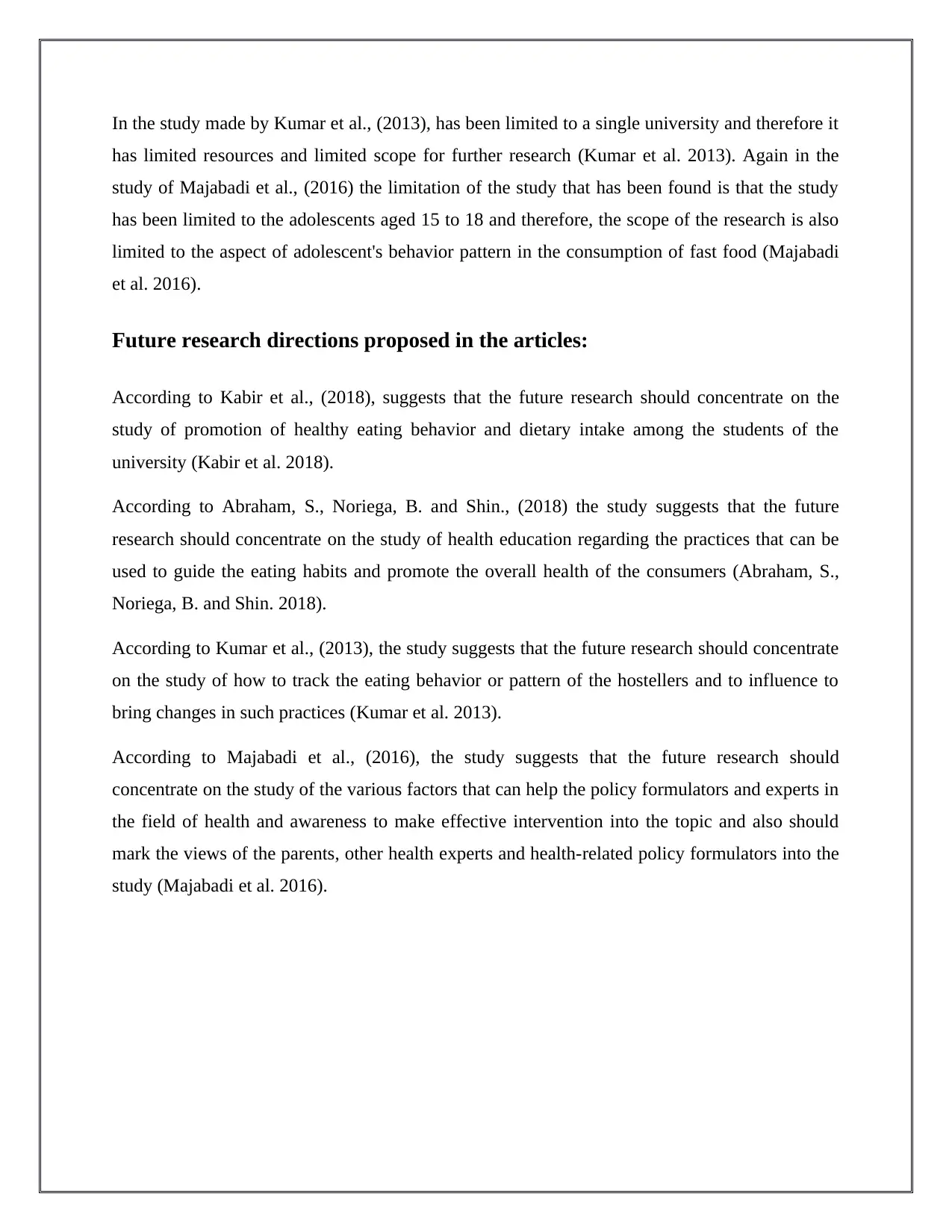
In the study made by Kumar et al., (2013), has been limited to a single university and therefore it
has limited resources and limited scope for further research (Kumar et al. 2013). Again in the
study of Majabadi et al., (2016) the limitation of the study that has been found is that the study
has been limited to the adolescents aged 15 to 18 and therefore, the scope of the research is also
limited to the aspect of adolescent's behavior pattern in the consumption of fast food (Majabadi
et al. 2016).
Future research directions proposed in the articles:
According to Kabir et al., (2018), suggests that the future research should concentrate on the
study of promotion of healthy eating behavior and dietary intake among the students of the
university (Kabir et al. 2018).
According to Abraham, S., Noriega, B. and Shin., (2018) the study suggests that the future
research should concentrate on the study of health education regarding the practices that can be
used to guide the eating habits and promote the overall health of the consumers (Abraham, S.,
Noriega, B. and Shin. 2018).
According to Kumar et al., (2013), the study suggests that the future research should concentrate
on the study of how to track the eating behavior or pattern of the hostellers and to influence to
bring changes in such practices (Kumar et al. 2013).
According to Majabadi et al., (2016), the study suggests that the future research should
concentrate on the study of the various factors that can help the policy formulators and experts in
the field of health and awareness to make effective intervention into the topic and also should
mark the views of the parents, other health experts and health-related policy formulators into the
study (Majabadi et al. 2016).
has limited resources and limited scope for further research (Kumar et al. 2013). Again in the
study of Majabadi et al., (2016) the limitation of the study that has been found is that the study
has been limited to the adolescents aged 15 to 18 and therefore, the scope of the research is also
limited to the aspect of adolescent's behavior pattern in the consumption of fast food (Majabadi
et al. 2016).
Future research directions proposed in the articles:
According to Kabir et al., (2018), suggests that the future research should concentrate on the
study of promotion of healthy eating behavior and dietary intake among the students of the
university (Kabir et al. 2018).
According to Abraham, S., Noriega, B. and Shin., (2018) the study suggests that the future
research should concentrate on the study of health education regarding the practices that can be
used to guide the eating habits and promote the overall health of the consumers (Abraham, S.,
Noriega, B. and Shin. 2018).
According to Kumar et al., (2013), the study suggests that the future research should concentrate
on the study of how to track the eating behavior or pattern of the hostellers and to influence to
bring changes in such practices (Kumar et al. 2013).
According to Majabadi et al., (2016), the study suggests that the future research should
concentrate on the study of the various factors that can help the policy formulators and experts in
the field of health and awareness to make effective intervention into the topic and also should
mark the views of the parents, other health experts and health-related policy formulators into the
study (Majabadi et al. 2016).
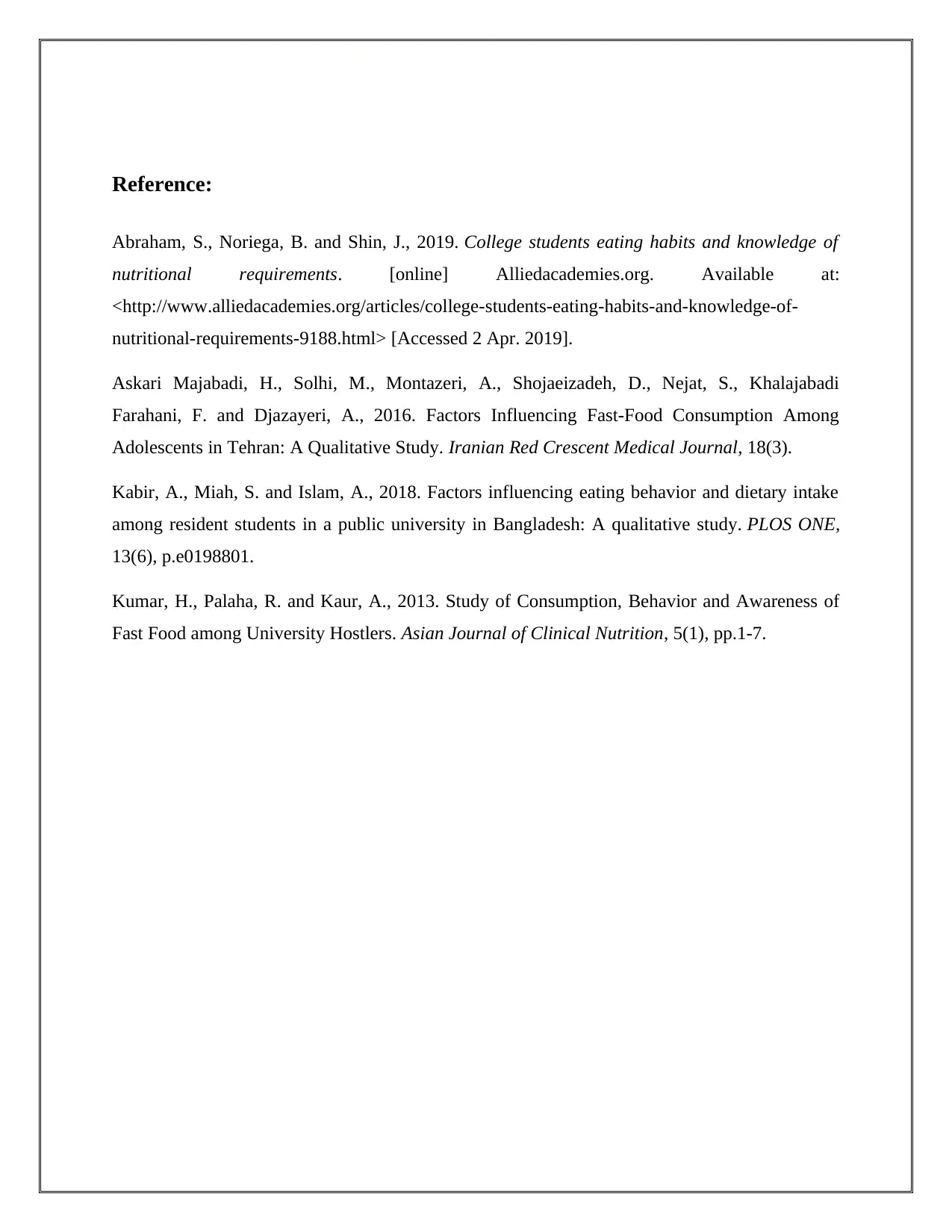
Reference:
Abraham, S., Noriega, B. and Shin, J., 2019. College students eating habits and knowledge of
nutritional requirements. [online] Alliedacademies.org. Available at:
<http://www.alliedacademies.org/articles/college-students-eating-habits-and-knowledge-of-
nutritional-requirements-9188.html> [Accessed 2 Apr. 2019].
Askari Majabadi, H., Solhi, M., Montazeri, A., Shojaeizadeh, D., Nejat, S., Khalajabadi
Farahani, F. and Djazayeri, A., 2016. Factors Influencing Fast-Food Consumption Among
Adolescents in Tehran: A Qualitative Study. Iranian Red Crescent Medical Journal, 18(3).
Kabir, A., Miah, S. and Islam, A., 2018. Factors influencing eating behavior and dietary intake
among resident students in a public university in Bangladesh: A qualitative study. PLOS ONE,
13(6), p.e0198801.
Kumar, H., Palaha, R. and Kaur, A., 2013. Study of Consumption, Behavior and Awareness of
Fast Food among University Hostlers. Asian Journal of Clinical Nutrition, 5(1), pp.1-7.
Abraham, S., Noriega, B. and Shin, J., 2019. College students eating habits and knowledge of
nutritional requirements. [online] Alliedacademies.org. Available at:
<http://www.alliedacademies.org/articles/college-students-eating-habits-and-knowledge-of-
nutritional-requirements-9188.html> [Accessed 2 Apr. 2019].
Askari Majabadi, H., Solhi, M., Montazeri, A., Shojaeizadeh, D., Nejat, S., Khalajabadi
Farahani, F. and Djazayeri, A., 2016. Factors Influencing Fast-Food Consumption Among
Adolescents in Tehran: A Qualitative Study. Iranian Red Crescent Medical Journal, 18(3).
Kabir, A., Miah, S. and Islam, A., 2018. Factors influencing eating behavior and dietary intake
among resident students in a public university in Bangladesh: A qualitative study. PLOS ONE,
13(6), p.e0198801.
Kumar, H., Palaha, R. and Kaur, A., 2013. Study of Consumption, Behavior and Awareness of
Fast Food among University Hostlers. Asian Journal of Clinical Nutrition, 5(1), pp.1-7.
⊘ This is a preview!⊘
Do you want full access?
Subscribe today to unlock all pages.

Trusted by 1+ million students worldwide
1 out of 6
Related Documents
Your All-in-One AI-Powered Toolkit for Academic Success.
+13062052269
info@desklib.com
Available 24*7 on WhatsApp / Email
![[object Object]](/_next/static/media/star-bottom.7253800d.svg)
Unlock your academic potential
Copyright © 2020–2025 A2Z Services. All Rights Reserved. Developed and managed by ZUCOL.




